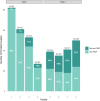A pragmatic approach to identifying implementation barriers and facilitators for a novel pre-exposure prophylaxis (PrEP) delivery model at public facilities in urban Uganda
- PMID: 35090560
- PMCID: PMC8795935
- DOI: 10.1186/s43058-022-00254-w
A pragmatic approach to identifying implementation barriers and facilitators for a novel pre-exposure prophylaxis (PrEP) delivery model at public facilities in urban Uganda
Abstract
Background: Scalable HIV pre-exposure prophylaxis (PrEP) delivery models for resource-limited settings are critical for improving PrEP coverage and interrupting HIV transmission. This research uses technical assistance (TA) reports to evaluate implementation barriers and facilitators for a novel delivery model integrating PrEP and antiretroviral therapy (ART) delivery for HIV sero-different couples in public health facilities in Kampala, Uganda.
Methods: We used data from the Partners PrEP Program (PPP)-a stepped-wedge cluster randomized trial that is launching PrEP delivery through an integrated model of oral PrEP and antiretroviral therapy (ART) delivery for HIV sero-different couples at public health facilities in Kampala and Wakiso, Uganda (NCT03586128). Technical assistance teams, comprised of PPP program staff, conducted monthly TA visits to implementing facilities where they identified and addressed implementation challenges in collaboration with health facility staff. Findings were recorded in TA reports, a standardized form structured using the Consolidated Framework for Implementation Research (CFIR). We used a conceptual content analysis approach to evaluate TA reports completed from January to December 2019 and identify implementation barriers and facilitators.
Results: Among 39 reports from the 8 implementing facilities (~ 5 per facility), we identified 11 CFIR constructs. Key implementation facilitators included sensitizing and educating facility staff about PrEP (knowledge and beliefs about the innovation); establishing formal and informal feedback and accountability mechanisms (reflecting and evaluating); and empowering facility staff to address implementation challenges (self-efficacy). Key implementation barriers were related to ineffective recruitment and referral of sero-different couples to and from nearby facilities (cosmopolitanism) as well as stockouts of laboratory resources and testing supplies (available resources).
Conclusions: This analysis featured a robust implementation science framework to assess the relationship between early implementation determinants and outcomes of this innovative PrEP delivery model. Further, we have provided important descriptions of early implementation barriers and facilitators that will inform scale-up efforts for PrEP delivery within and beyond Uganda. Future work will refine the analysis of pragmatic program data, qualitatively investigate the identified key themes, and explore strategies for addressing implementation barriers.
Keywords: Barriers; CFIR; Facilitators; HIV; Implementation; LMIC; PrEP; Uganda.
© 2022. The Author(s).
Conflict of interest statement
The authors declare that they have no competing interests.
Figures
References
-
- Organization WH . Guideline on when to start antiretroviral therapy and on pre-exposure prophylaxis for HIV: World Health Organization. 2015. - PubMed
-
- Pintye J, Davey DLJ, Wagner AD, John-Stewart G, Baggaley R, Bekker L-G, et al. Defining gaps in pre-exposure prophylaxis delivery for pregnant and post-partum women in high-burden settings using an implementation science framework. Lancet HIV. 2020;7(8):e582–ee92. doi: 10.1016/S2352-3018(20)30102-8. - DOI - PMC - PubMed
Grants and funding
LinkOut - more resources
Full Text Sources
Medical
Miscellaneous


